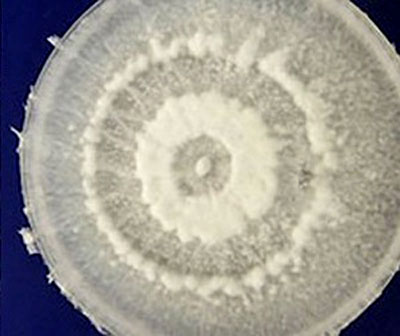|

by Rady Ananda
February 6, 2012
from
ActivistPost Website
|
Rady Ananda is an
investigative reporter and researcher in the areas of
health, environment, politics, and civil liberties. Her
two websites, Food Freedom and COTO Report are essential
reading. |

Pestalotiopsis
microspora
by Yale University
Researchers have found the first
endophytic fungus that eats plastic, and can use it as its sole food
source even in an oxygen-free environment. [1]
Pestalotiopsis microspora
presents a massive bioremediation opportunity for landfills, where
buried and surface plastics can be degraded naturally. More likely,
though, the enzyme responsible for degrading polyurethane (PUR)
will be tweaked, patented and commercialized.
There will be no mad escape into urban
centers where the mold will eat all our plastics, like medical
scientist Kit Pedler envisioned in his sci-fi classic,
Mutant 59 - The Plastic Eaters.
One hopes, anyway.
Dubbed the “the E. coli of temperate and tropical rainforest
systems,” P. microspora is ubiquitous in rainforests around the
world, signifying its substantial role in forest ecosystem health.
[2]
It also produces
taxol, a chemical used to treat breast and ovarian
cancers, though the Himalayan yew is more commercially profitable
for extracting it.
The PUR-degrading enzyme,
“is extracellular, secreted and
diffusible,” said the Yale University researchers who made the
discovery.
The jungle fungus spits out an enzyme
that diffuses to “a significant distance” from its body, expanding
the potential range of cleanup.
Though touted in the media as a mushroom, P. microspora is actually
a mold belonging to the
Ascomycota phylum. Mushrooms belong to Basidiomycota. As an endophyte, it lives symbiotically within
plants, whereas mushrooms tend to be ectophytes that live on
plants.
Traveling to Ecuador’s rainforest as part of Yale’s annual
Rainforest Expedition and Laboratory course taught by molecular
biochemistry professor Scott Strobel, several students collected
woody plants of various families in the Yasuni National Forest in
2008. [3]
The winning fungal isolates came from the guava tree (Psidium
guajava) and the custard apple tree (Annona muricata), though
several different fungal species from a variety of trees
demonstrated the ability to efficiently degrade polyurethane.
“Two Pestalotiopsis microspora
isolates were uniquely able to grow on PUR as the sole carbon
source under both aerobic and anaerobic conditions,” the study
reports, noting that not all the P. microspora isolates shared
this ability, likely due to genetic variability within the
species.
Professor Strobel’s father, Gary, has
been a bioprospector for over 30 years, licensing,
“more than 20 specimens to the likes
of Eli Lilly, Chevron, and Dow Chemical,” reports Forbes.
[4]
It was his discovery in 1993 of P.
microspora’s ability to synthesize taxol. Four years later, he
discovered a fungus that emits antibiotic gases.
He licensed
Muscodor albus,
“to Agraquest of Davis, Calif.,
which is turning it into an organic soil fumigant, and to other
firms for treating waste in portable toilets.”
Credited with first introducing
polyurethanes,
I.G. Farben - now Bayer [5]
- is also notorious for its
Zyklon B used in Nazi gas chambers, and
for its medical experiments on Nazi prisoners. [5]
It began synthesizing PURs in 1937 and
commercialized them in the 1940s. [6]
Since then, plastic pollution has circumnavigated the globe,
collecting in ocean gyres [7], contributing to finite
landfills, and poisoning the biosphere. Nearly 300 million tons of
plastic were produced in 2010, and the amount produced this century
already exceeds the total amount produced in the 20th century.
[8]
PUR is also a significant component of
nanotechnology, allowing the
development of nanowebs, nanotubes and other nanomaterials.
Medical uses of nano-PURs include
artificial implants like cardiac valves and regenerative membranes
for neurons, bones and other tissues.
“This ability to tailor surface
chemistry, create nanoscale architectures and potentially match
the mechanical properties of tissues makes nanocomposites
particularly attractive for biomedical applications,” wrote
researchers in 2010, “where they have been advocated as novel
biomaterials and as scaffolds for tissue-engineering
applications.” [6]
If the synthetic life forms found in
Morgellons patients [9] are partially composed of
polyurethane - and it seems they likely are given its elasticity,
strength and shape memory - this fungus might break them down.
You’d have to worry about horizontal
gene transfer, though.
It may be best to wait, along with
landfills, for the synthetic version.
Notes
[1] Russell, et al.
“Biodegradation of Polyester Polyurethane by Endophytic
Fungi,” doi: 10.1128/AEM.00521-11 Appl. Environ. Microbiol.
September 2011 vol. 77 no. 17 6076-6084. Available at
http://aem.asm.org/content/early/2011/07/15/AEM.00521-11.full.pdf
[2] Anneke M. Metz, et al. “Induction of the sexual stage of
Pestalotiopsis microspora, a taxol-producing fungus,”
Microbiology, August 2000 vol. 146 no. 8 2079-2089. http://mic.sgmjournals.org/content/146/8/2079.full
[3] Bruce Fellman, “A Fungus That Eats Polyurethane,” Yale
Alumni Mag., Nov./Dec. 2011. http://www.yalealumnimagazine.com/issues/2011_11/findings_fungus.html
[4] Christopher Helman, “Driving on Mushroom Fumes,” 6 May
2009. http://www.forbes.com/forbes/2009/0525/036-biofuels-diesel-organic-driving-on-mushroom-fumes.html
[5] Bayer A.G., “Bayer Investor Relations: FAQs,” n.d.
Accessed 5 Feb. 2012. http://www.investor.bayer.com/en/service/faqs/
[6] Dr Rath Foundation, “The History of the ‘Business with
Disease’,” n.d. Accessed 5 Feb. 2012.
http://www4.dr-rath-foundation.org/PHARMACEUTICAL_BUSINESS/history_of_the_pharmaceutical_industry.htm
[7] Tianxi Liu and Shuzhong Guo, Properties of
Polyurethane/Carbon Nanotube Nanocomposites, in “Polymer
Nanotube Nanocomposites: Synthesis, Properties, and
Applications,” Vikas Mittal, ed. John Wiley & Sons, 2010.
pp.141-176. Available at http://bit.ly/zukuco
[8] 5 Gyres Institute, “Global Research: Collecting data
from the world’s oceans,” n.d. Accessed 5 Feb. 2012.
http://5gyres.org/global_research
[9] Richard C. Thompson, et al. “Plastics, the environment
and human health: current consensus and future trends,”
doi:
10.1098/rstb.2009.0053. Philosophical Transactions of the
Royal Society, B 27 July 2009 vol. 364 no. 1526 2153-2166.
http://rstb.royalsocietypublishing.org/content/364/1526/2153.full
|

